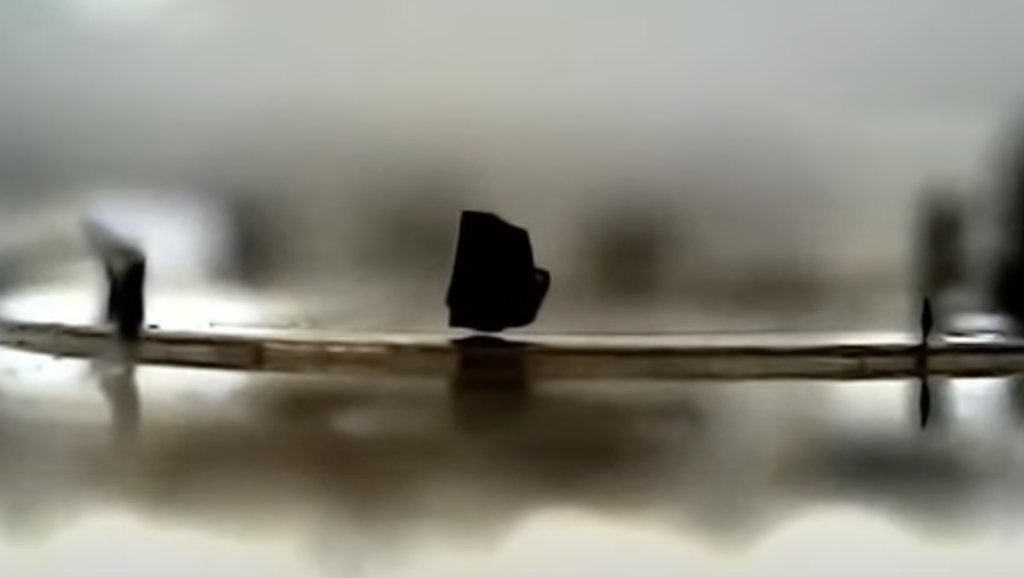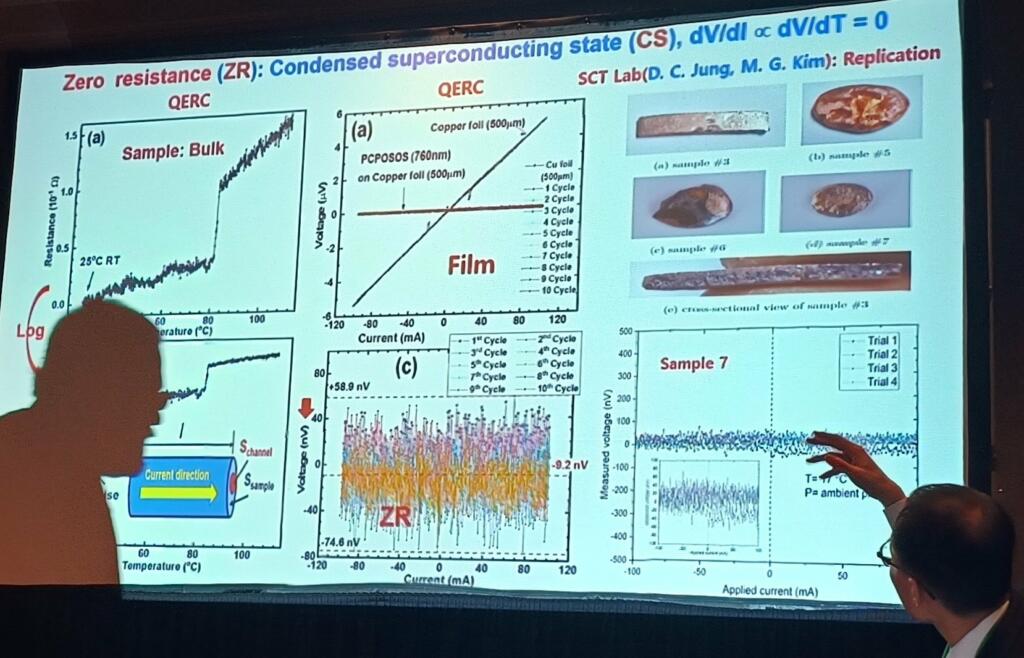There are some people who expected more from the PCPOSOS room temperature superconductor talk. They strangely expected the team to bring the sample and show it live. BUT that is not what the abstract of the talk said. The abstract said they would show two videos of levitation and two videos of magnets. This is what was done for the ten minute talk.
The presentation did NOT have evidence that was irrefutable. There is progress being made but the purity and strength of the effects have not made large advances.
The biggest advances seem to be the complete levitation video.
One grain was fully levitating and not resting on any surface. This is significant.
NOTE: None of the critics who wrote paper saying it was all sulfur contamination have produced any partial or full levitations using these materials. The sulfur contamination theorists have some resistivity readings that approximate some of the readings. Whoopdy doo. Make you sulfur contamination float or partially float, then we can talk about your diamagnetic or other magnetic theories as the reason. But make the magic happen, then I can believe your reason why.
There is now experimental replication by another Korean team (SCT Lab). This is a big deal. Everyone kept asking for experimental replication.

LK99 with sulfur chemically bonded to some of the carbon is PCPOSOS. LK99 is Pb10-xCux(PO4)6O PCPOSOS is Pb10-xCux(P(O1-ySy)4)6O1-zSz
— nextbigfuture (@nextbigfuture) March 4, 2024
The Korean and Chinese teams will need to gather better data and results for papers and patents.
A ten minute talk is not sufficient time to perform a live demonstration. Also, they had to magnify the small sample hundreds of times for visibility. They are not making much of the material.
I did not expect they would bring a sample. Their samples, the Korean team replicating and the Chinese teams now replicating are tiny and potentially highly valuable.
Many critics will not be convinced until this is mass produced and they are given samples to work on.
The teams are incentivized to get their patents and work out reliable production. They do not get value by convincing doubting scientists. They get value by convincing venture capital.
Billions have gone to funding nuclear fusion energy companies. None of those companies have lit a light bulb with nuclear fusion power. The vast majority of people and many scientists say that nuclear fusion is 20 years away and always will be. What is the value to companies working in that field to convince doubters and critics? How do they reach their goals of commercializing fusion technology and solving nuclear fusion science by convincing critics?
Final stills from Hyun-Tak Kim’s talk on partial levitation of #superconductors at room temperature at #APSMarch pic.twitter.com/kvOYd8hFKo
— Victoria Merriman (@vikmez) March 4, 2024
Abstract
We synthesized materials, Pb10-xCux(P(O1-ySy)4)6O1-zSz (PCPOSOS), called PCPOSOS, which exhibit superconducting behavior at room temperature and atmospheric pressure. These materials displayed characteristics of a superconductor, including zero resistance, the Meissner effect, and partial levitation when placed on a magnet (arXiv: 2307.12037). The partial levitation is caused by an inhomogeneity in the magnetic field of the magnet and occurred within the range of critical magnetic fields, Hc1 and Hc2. That is, the magnetic field of the magnet increased with going from center to the edge of magnet. The magnet had approximately 2000G at the center and approximately 3,000G at its edge. The levitation occurred near center. This indicates the center of the magnet is close to Hc1. It disappeared between center and the edge near Hc2, with Hc1 being much smaller than Hc2, because the magnetic moment at Hc2 is much smaller than that at Hc1. When the magnet is slightly moved, the levitation returns to its original position. This phenomenon is analyzed as flux pinning, which is typical of a type-II superconductor. Moreover, the quantum-locking phenomenon, characteristic of a Type-I superconductor, may appear. However, we interpret PCPOSOS as a Type-II superconductor. We will show two videos of levitations and two videos of magnets.




Brian Wang is a Futurist Thought Leader and a popular Science blogger with 1 million readers per month. His blog Nextbigfuture.com is ranked #1 Science News Blog. It covers many disruptive technology and trends including Space, Robotics, Artificial Intelligence, Medicine, Anti-aging Biotechnology, and Nanotechnology.
Known for identifying cutting edge technologies, he is currently a Co-Founder of a startup and fundraiser for high potential early-stage companies. He is the Head of Research for Allocations for deep technology investments and an Angel Investor at Space Angels.
A frequent speaker at corporations, he has been a TEDx speaker, a Singularity University speaker and guest at numerous interviews for radio and podcasts. He is open to public speaking and advising engagements.


The cooling transformation of a semiconductor into a superconductor is an adiabatic transformation. If its charge carriers’ motions are periodic, then this quantity 2T/n is an adiabatic invariant, where T is the time average of the kinetic energy (related to the k-vector on the Dispersion diagram showing the semiconductor’s charge-carrier band structure T=0.5×m×v^2=0.5×p^2÷m=0.5×(hk)^2÷m) and n is the frequency of the motion.
This adiabatic invariant can be used for computing where the charge carriers go as they transition through the superconductor’s critical temperature.
The charge carriers corraled in a rather flat energy band near the Fermi energy level can transition to a nearby energy band if their mass changes such as via the fermions to bosons transition, thereby becoming superconducting charge carriers.
I believe in the raisin-pudding model until I bite into it and chip off my tooth ! Just like Rutherford, precipitating a major ultraviolet catastrophe in Physics.
“I did not expect they would bring a sample. Their samples, the Korean team replicating and the Chinese teams now replicating are tiny and potentially highly valuable. ”
Once again, videos and charts but **NO** samples.
Scam artist alert is ringing loudly.
For all who believe them, I ask, “*IF* they were scam artists, how would their behavior differ?”
[ Yes, maybe, but how could they be doing this with observation&review from all experts in that matter? Maybe their behaviour would not differ (maybe it does within a closer view, is it about ‘funding’?) but their aims&precautions, because they know the risks?
Think about responsible decisions to be done with nuclear fusion enabled for power plants? (and whom to avoid or supply with?)
With an approximately 100% efficiency for electricity transfer, there’s no margin left for improvement? ]
Nuclear fusion enabled for power plants isn’t worth being worried about much aside from the shielding of the neutrons created. Nuclear fusion is so difficult to achieve that anything going wrong will result in the fusion reaction shutting down, thereby halting any potential explosion.
Approximately 100% efficiency of electric energy transfer is great for the world, too. Just imagine how much poverty can be reduced worldwide !
[ Yes, a world of grateful and altruistic humans (can and will be) rising with(in) a 21. century (wrt to occidental calendar), but don’t build all of them 100s TW of heat production nuclear fusion within decades (gulf stream ~1500TW, heat from sun on Earth’s atmosphere ~174000TW (~1/2 on ground&surface), nuclear reactions inside Earth’s core ~4-11TW, electric energy consumption ~2.7_2019(-3.3TW_2022), primary energy needs ~19(-22)TW, heat from Earth’s core and mantle ~44TW) on planet Earth’s surface (inside the atmosphere)?
~36.8GtCO2_2022 (billion metric tons; CO2: ~414 parts per million), on a global fossil fuel share of ~62.3% (coal ~1/3(36%) from fossil fuels).
statista,com explains “As of July 2023, most nuclear reactors in the world had been operational for over 30 years. At the time, the mean age of reactors was 31.4 years, with 71 nuclear reactors having been connected to the power grid within the last 10 years.”
China has been building ~21 new nuclear fission reactors (power plants), adding to already grid connected ~55. USA currently ~93, France ~56.
About 3/4 are ‘pressurized light-water moderated and cooled reactors (PWR)’, followed by ~46 ‘pressurized heavy-water moderated and cooled reactors’, ~65 other types (~yr2023).
Priorities?
“China had the greatest new solar photovoltaic capacity additions worldwide in 2022, at some 106 gigawatts. The global solar PV cumulative capacity increased massively over the past 20 years. In the year 2000, the capacity amounted to just over one gigawatt and by 2021 had surpassed one terawatt. Solar capacity is expected to continue to rise as renewables increase their role in the global energy mix. The United States increased its solar photovoltaic capacity by 18.6 gigawatts in 2022.”
hypothesis: Solar energy conversion is hope for poor (wrt. capitalistic, accumulated wealth, ‘climate change’ risks on assets) countries. (?) ]
“China had the greatest new solar photovoltaic capacity additions worldwide in 2022, at some 106 gigawatts.”
China is NOT given the respect and thanks it deserves for making solar power panels the inexpensive, easy to obtain, and high quality that they are. It was NOT the USA, or Europe, or Japan, or India… it was China that made producing solar energy a top priority and spent the resources to make it happen. Yes, China is still building coal plants BUT that is only because they need to use every energy production means available so that they can to produce enough energy to keep up with their needs. Electric vehicles, cheap high quality batteries, high-speed rail, etc. China is committed to a green future and is leading the way.
Thank you… thank you… thank you
[ saying, ‘ask people on both sides of the story’, and on many levels of social positions and during longer periods of time _ what’s a summary from that?
me thinking about
“With an approximately 100% efficiency for electricity transfer, there’s no margin left for improvement?”,
there’s still demand for maintenance&replacement&expansion (with a power grid in mind) and there’s e.g. electric motors that are up to ~97% (IE4, IE5 (‘https://new.abb.com/news/detail/106779/abb-is-first-in-world-to-deliver-ie5-ultra-premium-motor-efficiency-in-explosive-environments ‘), on gt 100kW, ~MW scale towards e.g. ~99% for generators on ~GW power plants)
interesting side note:
“The DoE states that electric cars convert over 77% of the electrical energy from the grid to power at the wheels. […]”